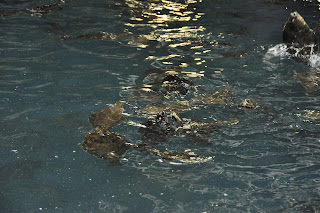




What an intense, but incredible day I had! I woke up at about 5:30 this morning so I could give myself an hour to walk over to the fish farm here in Husavik, Fiskeldid Haukmyri, on the opposite side of the bay. I gauged it right on and arrived by 7, the time I had arranged my visit. I was greeted by Fannar and his crew with coffee, warm smiles, and the smell of money- I mean fish. Among many tanks, they have 6 outside with green netting placed on top like a circus tent. This is what I can see from my room here.
This operation differs a lot from the other in many way. Not only do they produce different species from the farm in Husavik, but this operation is much bigger and they use salted water. They have a total of about 20 boreholes within a 1 km radius. Depending on where the hole is, they will have varied temperatures and salt content. There is a mixing chamber where all the water is collected, mixed, and then distributed to the tanks. It is quite similar to the farm in Husavik in terms of its process, but there is also quite a lot of variability between the two also. They have a collection pond for the effluent, where the 'goodies' (poop and left over food) can sink to the bottom and they water can be cleaned before entering the ocean. One thing, though, that I found to be inconsistent was that they don't recycle water like the previous operation because they believe they have a lot of it and they don't need to be hung up about it. At the same time, the pond on the opposite site is constantly being monitored for fear of pumping too much water out of it. It would be nice to find a way for the water to be reused in the process. Since they are growing different species, they require different temperatures. I wonder if there would be a way to set this up as hot to cold- the hotter water would cool as it goes through the different fish and preferential temperatures.
The tanks here were MASSIVE!! For salmon, they are made from concrete. For the flat fish, they use similar ones to what I saw early in the morning, green plastic. The salmon seemed quite happy. I saw them in different stages, and they were jumping out of the water and being very active. However, something funny was happening with the Halibut. They only recently started growing them, and this is an emergent fish species for farming. In other words, not very much research has been able to be conducted in regards to the favorability of their environment. They are doing research and experiments in regards to this, but what was strange was that they were behaving as they typically would not in nature. They were all moving between the top 1-2 meters of water, bending backwards and putting their mouths in the air. I have never seen fish do this. This is mass production, and so it would be interesting to find out if this situation stresses the Halibut and forces them to do this. They aren't sure why they do this either. It was incredibly fascinating to see to two farms back to back, especially since they are so different in their own right.
Since I had the car, I decided to make a few pit stops on my way back to Husavik. There is a National Park area called Jokulsargljufur. Here, there is the Asbyrgi canyon which is about 3.5 km long (N-S) and about 1 km wide. There is a gorge on its most northern side, which is just spectacular. I spent a nice chunk of time watching and photographing the birds and the plant material. There are birches that have root suckled, and are the dominant tree species in most of these 'forests'. You can also hike around, and climb some of the rock edges, providing a spectacular view of this landscape. After, I drove along the canyon to see the various waterfalls, one of which is
It was an amazing day, but am exhausted. Looking forward to the break this weekend!
Image 1: Fiskeldid Haukmyri fish farm in Husavik- view taken from road walking over
Image 2: Silfurstjarnan fish farm near Kopaskur- Halibut doing strange things, notice the one that is jumping in the upper right hand corner!
Image 3: Silfurstjarnan fish farm near Kopaskur- outdoor concrete tanks for mature salmon. The one in the lower right were being harvested that day. Those are the ones you will buy from Whole Foods on Monday/Tuesday.
Image 4: Asbyrgi Gorge- View taken after climbing up the mountain side a bit. Notice the crazy orange 'moss' growing on the rocks. I thought it was beautiful.
Image 5: Dettifoss waterfall- Europe's most powerful one, getting closer and closer to it. Love seeing nature in the cracks.
No comments:
Post a Comment